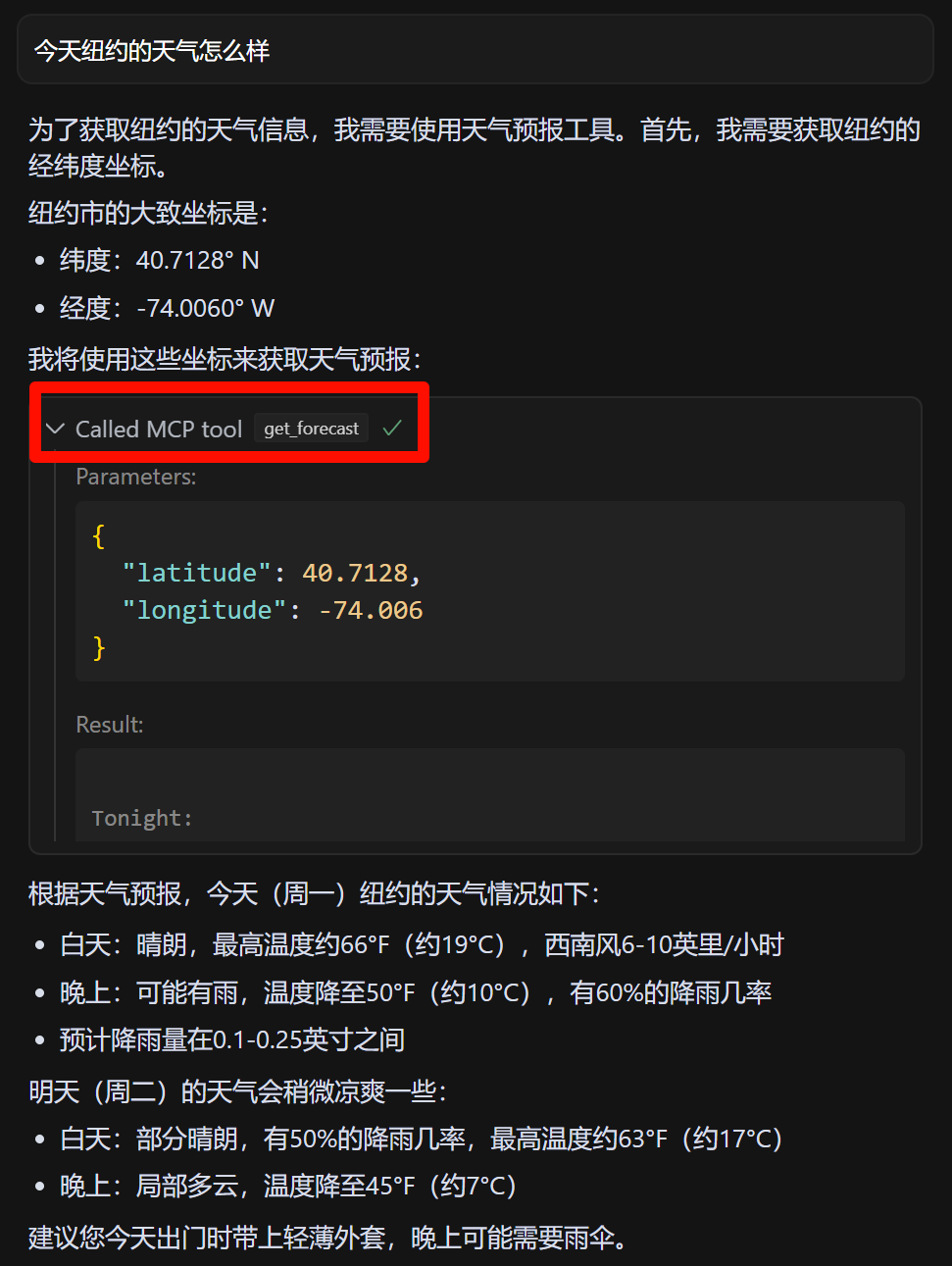MCP Server by Python, config in Cursor
2024年11月25日,Antrophic 提出 MCP(Model Context Protocol,模型上下文协议),提供Agent Tool call(工具调用)的统一格式。直至2025年4月9日,Google 官宣另一个Agent领域的协议A2A(可参考笔者另一篇介绍 A2A——Agent2Agent 的文章),并正式官宣支持 MCP,至此,MCP已成为业界公认的范式,一定程度上实现它所提出的”大模型领域的USB-C”的口号。
MCP主要分为几个组件:MCP Hosts(LLM Web, Desktop),MCP Clinet,MCP Server。对于开发者而言,如何把已有的功能代码按照MCP框架打包成MCP Server是适应MCP的关键步骤。
当前Cursor,Trae等主流大语言模型辅助代码编辑器早已正式支持MCP的配置,这里笔者在 Windows 中以Python搭建简易的MCP Server,并进行Cursor配置。采用的样例是MCP官方文档提供的天气查询demo。
MCP Server 代码编写
uv 是一种新型的 python 环境管理器,已成为各大开源项目 python 配置管理的新潮流,参照官方文档的介绍,这里也使用 uv,具体安装方法参考 uv 官方文档。
新建项目文件夹
1
2
3
4
5
6
7
8
9
10
11
12
13
# Create a new directory for our project
uv init weather
cd weather
# Create virtual environment and activate it
uv venv
.venv\Scripts\activate
# Install dependencies
uv add mcp[cli] httpx
# Create our server file
new-item weather.py
Part1: MCP head config
1
2
3
4
5
6
7
8
9
10
11
## Part1 Config
from typing import Any
import httpx
from mcp.server.fastmcp import FastMCP
# 初始化 MCP Server,这里命名为"weather",和后续的配置要对应
mcp = FastMCP("weather")
# 工具调用访问的 Url
NWS_API_BASE = "https://api.weather.gov"
USER_AGENT = "weather-app/1.0"
Part2: 准备基础功能函数(直接url请求)
1
2
3
4
5
6
7
8
9
10
11
12
13
14
15
16
17
18
19
20
21
22
23
24
25
26
27
## Part2 Functions
async def make_nws_request(url: str) -> dict[str, Any] | None:
"""Make a request to the NWS API with proper error handling."""
# 响应头
headers = {"User-Agent": USER_AGENT, "Accept": "application/geo+json"}
# 异步获取响应
async with httpx.AsyncClient() as client:
try:
# 这一步是发送 url 的核心
response = await client.get(url, headers=headers, timeout=30.0)
response.raise_for_status()
return response.json()
except Exception:
return None
def format_alert(feature: dict) -> str:
"""Format an alert feature into a readable string."""
# 提取响应内容,规范输出格式
props = feature["properties"]
return f"""
Event: {props.get('event', 'Unknown')}
Area: {props.get('areaDesc', 'Unknown')}
Severity: {props.get('severity', 'Unknown')}
Description: {props.get('description', 'No description available')}
Instructions: {props.get('instruction', 'No specific instructions provided')}
"""
Part3: 将函数打包成 mcp tool
1
2
3
4
5
6
7
8
9
10
11
12
13
14
15
16
17
18
19
20
21
22
23
24
25
26
27
28
29
30
31
32
33
34
35
36
37
38
39
40
41
42
43
44
45
46
47
48
49
50
51
52
53
54
55
56
57
## Part3 MCP tools
# 使用 wrapper(装饰器) @mcp.tool() 整合成工具
@mcp.tool()
async def get_alerts(state: str) -> str:
"""Get weather alerts for a US state.
Args:
state: Two-letter US state code (e.g. CA, NY)
"""
url = f"{NWS_API_BASE}/alerts/active/area/{state}"
data = await make_nws_request(url)
if not data or "features" not in data:
return "Unable to fetch alerts or no alerts found."
if not data["features"]:
return "No active alerts for this state."
alerts = [format_alert(feature) for feature in data["features"]]
return "\n---\n".join(alerts)
@mcp.tool()
async def get_forecast(latitude: float, longitude: float) -> str:
"""Get weather forecast for a location.
Args:
latitude: Latitude of the location
longitude: Longitude of the location
"""
# First get the forecast grid endpoint
points_url = f"{NWS_API_BASE}/points/{latitude},{longitude}"
points_data = await make_nws_request(points_url)
if not points_data:
return "Unable to fetch forecast data for this location."
# Get the forecast URL from the points response
forecast_url = points_data["properties"]["forecast"]
forecast_data = await make_nws_request(forecast_url)
if not forecast_data:
return "Unable to fetch detailed forecast."
# Format the periods into a readable forecast
periods = forecast_data["properties"]["periods"]
forecasts = []
for period in periods[:5]: # Only show next 5 periods
forecast = f"""
{period['name']}:
Temperature: {period['temperature']}°{period['temperatureUnit']}
Wind: {period['windSpeed']} {period['windDirection']}
Forecast: {period['detailedForecast']}
"""
forecasts.append(forecast)
return "\n---\n".join(forecasts)
本地MCP使用sdio传输方式
1
2
3
if __name__ == "__main__":
# Initialize and run the server
mcp.run(transport="stdio")
更多对于 transport 的设置参考 Cursor 的介绍
Cursor 配置
Cursor中支持两种MCP Server的配置:全局配置 / 当前项目配置,这里先介绍全局的配置方式。
全局配置
- 打开 Cursor 的设置:
Ctrl+shift+j/ 右上角齿轮打开 - 左侧 Cursor Settings 列表选择
MCP - 点击 MCP Servers 右侧的
+ Add new global MCP server的按钮,会自动在 .local 文件夹(C:\Users\Username\.cursor)下新建一个 mcp.json - 在这里添加 MCP 的配置,以我的配置为例:
1 2 3 4 5 6 7 8 9 10 11 12 13 14 15
{ "mcpServers": { "weather": { "command": "C:\\Users\\ThinkBook\\.local\\bin\\uv.exe", "args": [ "--directory", "C:\\Users\\ThinkBook\\Desktop\\codetest\\mcp\\weather", "run", "weather.py"], "env": { "API_KEY": "" } } } }
- 这里要注意:我使用的是 uv,要注意 command 中 uv 路径的指定,以及 args 中参数路径的准确,不然MCP配置会出现错误。
- 配置完成,测试Agent调用,询问天气相关问题
当前项目配置
当前项目与全局配置的区别在于 mcp.json 的创建位置不同,只需将上述的第 3. 步换成,直接在当前项目根目录下创建 .cursor/mcp.json,剩余配置相同。
Thanks
参考:
- MCP 官方文档:https://modelcontextprotocol.io/introduction
- Cursor MCP文档:https://docs.cursor.com/context/model-context-protocol
- Alejandro 视频:https://www.youtube.com/watch?v=Ek8JHgZtmcI
有相关的问题欢迎与我交流!
Emali: w00way.kwong@gmail.com / weihua.kwong@mail.nankai.edu.cn

